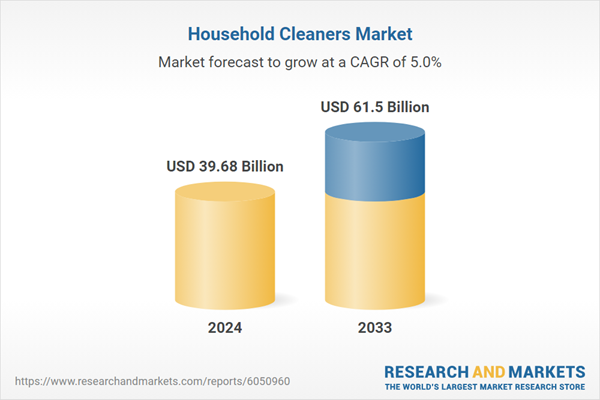Growth Trends in the US$61.5 Billion Household Cleaners
Dublin, March 25, 2025 (GLOBE NEWSWIRE) -- The "Household Cleaners Market Size and Share Analysis - Growth Trends and Forecast Report 2025-2033" has been added to offering.
The Household Cleaners market is expected to reach US$ 61.5 billion by 2033 from US$ 39.68 billion in 2024, with a CAGR of 4.99% from 2025 to 2033. The growing number of nuclear families, the rising level of living of consumers, and the growing demand for frozen and ready-to-eat food are the main factors propelling the market's expansion. Oven demand is expected to be fueled by the growing number of working women and the busy schedules of urban dwellers.

Living arrangements and lifestyles have changed significantly as a result of the worldwide urbanization movement. Smaller living areas, a denser population, and greater hygiene issues are all common characteristics of urban living. Additionally, urban inhabitants' fast-paced lifestyles have led to a predilection for time- and effort-saving, practical cleaning products. This tendency has been aided by the increasing number of dual-income households as well as the increased employment of women.
The use of efficient cleaning products to handle everyday cleaning duties has increased. In response, the industry is providing a variety of specialty products that are made to be applied quickly and easily and are tailored to diverse surfaces and cleaning requirements. It is anticipated that the ongoing urbanization trend and related lifestyle shifts will continue to be major factors influencing the household cleaning market.
The industry of household cleansers has benefited greatly from the growth of e-commerce, which has improved accessibility and convenience. Nowadays, customers may browse, evaluate, and buy a variety of cleaning supplies from the convenience of their homes. Brands may access a wider range of consumers, especially those in underserved or remote places, thanks to the online platform. Frequent online promotions and subscription models boost sales and foster customer loyalty.
Additionally, the internet facilitates the quick distribution of feedback and information, empowering customers to make better choices. Additionally, e-commerce platforms allow specialized and smaller firms to successfully compete with larger players, bringing diversity and innovation to the market. The market for home cleansers is expected to continue to increase due in large part to the ongoing expansion of online retail and the incorporation of technologies like artificial intelligence and tailored recommendations.
One major factor driving the household cleansers market is growing awareness of environmental preservation and the negative consequences of traditional cleaning solutions. The chemicals used in cleaning products and their possible effects on the environment and human health are topics that consumers are growing increasingly aware of. The demand for eco-friendly and green cleaning products has increased as a result of this awareness.
Nowadays, a lot of businesses are concentrating on creating non-toxic, biodegradable, and ecologically friendly products. These goods frequently include certifications like organic or cruelty-free, which appeals to a certain market of customers that value sustainability. Furthermore, laws and policies are changing, which forces producers to adhere to environmental requirements. The move to more environmentally friendly products creates new market niches and chances for creativity, which boosts industrial expansion.
Traditional manufacturers face serious competition from alternatives like do-it-yourself cleaning supplies. Simple, inexpensive DIY treatments made with substances like vinegar, baking soda, and essential oils are becoming more and more popular among consumers. Cost-consciousness and a desire for natural, non-toxic products are the main drivers of this movement.
Additionally, the industry is changing as a result of customers' increased preference for natural and organic cleaners and their need for goods free of harsh chemicals. Brands must thus adjust by providing safer, more environmentally friendly substitutes while satisfying increased demands for product efficacy, sustainability, and transparency. Traditional firms are being forced to adapt to the shifting tastes of their customers by the trend toward natural and do-it-yourself solutions.
The market for home cleansers is greatly influenced by regional and cultural tastes, necessitating that manufacturers modify their offerings to satisfy a range of demands. Stronger cleaners for stubborn stains or particular surfaces may be preferred by customers in some areas, while eco-friendly formulations or fragrance preferences may be more significant in others. Furthermore, the demand for specific product types can be influenced by environmental conditions such as humidity and air quality, as well as cleaning practices.
In order to be successful, brands need to create adaptable product lines that accommodate these differences, whether through regionally tailored packaging, localized perfumes, or focused formulas. Adapting marketing tactics to appeal to regional values and cultures is also essential for maintaining market relevance and customer happiness.
Both conventional and environmentally friendly solutions are in high demand in the US household cleansers market. Growing environmental and health consciousness has led to a growing preference among consumers for natural, biodegradable, and non-toxic substances. Major brands still control the majority of the industry, but smaller natural product companies and private labels are gaining ground. Surface cleansers, disinfectants, laundry detergents, and multipurpose cleaners are important product categories.
Smart cleaning solutions, refillable packaging, and intensified formulae are examples of innovations that are becoming more and more popular. Consumers may now more easily access a wide range of products thanks to the expansion of e-commerce, which is changing distribution networks. Furthermore, brands are being compelled by regulatory pressure regarding ingredient safety and sustainability to modify their formulas and packaging in order to satisfy consumer demands and adhere to environmental regulations.
Growing consumer desire for eco-friendly, sustainable products is propelling the household cleaning market in the United Kingdom. A larger trend toward ecologically concerned and health-sensitive living is reflected in consumers' growing desire for natural, non-toxic, biodegradable cleaners. In addition to well-known household brands, this trend is driving the expansion of natural and organic cleaning products. Surface cleaners, laundry products, disinfectants, and bathroom cleansers are some of the major market categories.
Reusable packaging and concentrated formulae are becoming more and more popular. Due of its convenience and diversity, e-commerce is still growing as a major distribution method. Government rules pertaining to chemical ingredients and environmentally friendly packaging are also pushing companies to develop new goods that satisfy consumer needs for sustainability and safety.
India's market for household cleaners is expanding quickly due to factors like urbanization, rising disposable incomes, and increased awareness of cleaning and hygiene. Surface cleansers, floor cleaners, and disinfectants are in greater demand as consumers choose branded, ready-to-use cleaning solutions. Yet, especially in rural regions, conventional cleaning techniques like soap, water, and homemade treatments are still frequently employed. As environmental and health concerns gain traction, the market is also seeing a trend toward eco-friendly and chemical-free products. Urban consumers are also drawn to high-end, specialty cleansers, like those with antibacterial qualities or those that target particular surfaces. The expansion of e-commerce is increasing accessibility, and businesses are adjusting to local tastes and a range of price points in order to serve the large Indian market.
Furthermore, in October 2023, Vim introduced a new scrubber that combines the advantages of a soft scrubber and a steel scrubber. Companies like Colin and Dettol were able to capitalize on this trend by providing convenient, user-friendly products that guarantee thorough cleaning. For instance, Dettol launched a campaign in September 2023 to encourage people to adopt better hand hygiene products, which offer effective and germ-killing cleaning solutions.
A growing middle class, rising urbanization, and growing awareness of cleanliness and hygiene are driving the United Arab Emirates' (UAE) household cleaners' market's expansion. Surface cleaners, multipurpose products, disinfectants, and floor cleaners are in high demand as UAE consumers turn more and more toward high-end, practical, and efficient cleaning solutions. In keeping with worldwide sustainability trends, there is also growing interest in non-toxic and environmentally friendly cleaning solutions.
Even though conventional cleaning techniques are still employed, consumers, particularly those living in cities, are increasingly choosing branded, readily usable goods. Because it gives customers more convenience and access to a large selection of goods, e-commerce is becoming more and more popular as a major distribution method. Brands are also modifying their products to accommodate regional tastes and cultural sensitivities.
| No. of Pages | 120 |
| Forecast Period | 2024-2033 |
| Estimated Market Value (USD) in 2024 | $39.68 Billion |
| Forecasted Market Value (USD) by 2033 | $61.5 Billion |
| Compound Annual Growth Rate | 4.9% |
| Regions Covered | Global |
4.1 Growth Drivers
4.2 Challenges
6.1 Type
6.2 Application
6.3 Distribution Channel
6.4 Country
7.1 Surface Cleaner
7.2 Glass Cleaner
7.3 Toilet Bowl Cleaner
7.4 Specialty Cleaners
7.5 Bleaches
7.6 Others
8.1 Kitchen Cleaners
8.2 Bathroom Cleaners
8.3 Fabric Care
8.4 Floor Cleaner
9.1 Online
9.2 Offline
10.1 North America
10.1.1 United States
10.1.2 Canada
10.2 Europe
10.2.1 France
10.2.2 Germany
10.2.3 Italy
10.2.4 Spain
10.2.5 United Kingdom
10.2.6 Belgium
10.2.7 Netherlands
10.2.8 Turkey
10.3 Asia-Pacific
10.3.1 China
10.3.2 Japan
10.3.3 India
10.3.4 Australia
10.3.5 South Korea
10.3.6 Thailand
10.3.7 Malaysia
10.3.8 Indonesia
10.3.9 New Zealand
10.4 Latin America
10.4.1 Brazil
10.4.2 Mexico
10.4.3 Argentina
10.5 Middle East & Africa
10.5.1 South Africa
10.5.2 Saudi Arabia
10.5.3 UAE
11. Porter's Five Analysis
11.1 Bargaining Power of Buyers
11.2 Bargaining Power of Suppliers
11.3 Degree of Rivalry
11.4 Threat of New Entrants
11.5 Threat of Substitutes
12. SWOT Analysis
12.1 Strength
12.2 Weakness
12.3 Opportunity
12.4 Threat
13. Company Analysis
For more information about this report visit https://www.researchandmarkets.com/r/lsqopo
About ResearchAndMarkets.com
ResearchAndMarkets.com is the world's leading source for international market research reports and market data. We provide you with the latest data on international and regional markets, key industries, the top companies, new products and the latest trends.









